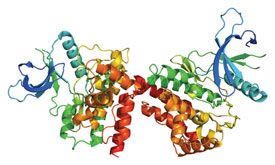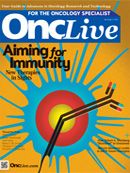Publication
Article
Oncology Live®
JAK-STAT Signaling Has Many Faces: Inhibitors Offer Hope in Rare Blood Cancers
Author(s):
Intense research has resulted in JAK-STAT becoming one of the best-understood signal transduction cascades.

Structure of the JAK2 protein.
In the 2 decades since the discovery of the JAK-STAT signaling pathway, intense research has resulted in its becoming one of the best-understood signal transduction cascades.
However, it is only in recent years that cancer researchers have begun to enjoy the fruits of this research, and even now JAK inhibitors are in their infancy compared with other targeted therapies. The development of these agents may offer new hope, particularly for treatment-resistant forms of chronic leukemia.
The Basics of JAK/STAT Signaling
Found in slime molds and humans alike, JAK-STAT signaling is relatively simple, as signal transduction pathways go. There are 3 principal components: a receptor, a member of the Janus kinase (JAK) family, and a member of the signal transducer and activator of transcription (STAT) family. This pathway handles incoming signals from a number of different membrane receptors, most importantly the cytokine receptors.
Named originally for the 2-faced god of Roman mythology, JAK is involved in signal transduction in both normal cells and disease states. It was often referred to as “Just Another Kinase” because its role initially was not fully defined. We now know that there are 4 members of the JAK family of nonreceptor tyrosine kinases: JAK1, JAK2, JAK3, and tyrosine kinase 2 (TYK2).
Once activated, the JAKs phosphorylate their major target, the STATs, of which there are 7. The STATs are transcription factors that normally lie dormant in the cytoplasm, but when phosphorylated they move into the nucleus where they bind to specific DNA sequences and drive or inhibit the suppression of target genes.
This relatively simple mechanism offers a means of directly translating incoming signals from outside the cell into cellular responses much more quickly than other signal transduction pathways, with each particular type of receptor-JAK-STAT combination driving a specific response. What is more complex and less well-understood is the considerable crosstalk between JAK-STAT and other signaling pathways.
Important in Hematopoiesis, Blood Cancer
JAK activation stimulates numerous cellular processes, including proliferation, differentiation, migration, and apoptosis. It plays a particularly important role in the formation and development of blood cells (hematopoiesis) and in proper immune function. Aberrant JAK-STAT signaling is therefore implicated in the development of blood cancer.
It was not until 2005 that mutations in the JAK gene were directly linked to the development of cancer, with the identification of the V617F point mutation in JAK2. This defect has subsequently been shown to be important in the development of myeloproliferative neoplasms (MPNs), characterized by the overproduction of blood cells.
The MPNs can be further characterized by the presence or absence of the Philadelphia chromosome, a chromosomal abnormality in which parts of chromosomes 9 and 22 break off and exchange places. The result is that 2 genes, breakpoint cluster region (BCR) and Abelson tyrosine kinase (ABL), form the oncogenic BCR-ABL fusion.
The treatment of MPNs initially showed promise with the development of targeted therapies such as gefitinib (Iressa, AstraZeneca) and imatinib (Gleevec, Novartis). However, patients with the 3 Philadelphia chromosome-negative forms of MPN, namely myelofibrosis (MF), polycythemia vera (PV), and essential thrombocythemia (ET), were resistant to these treatments. The JAK2 V617F mutation has been detected in >80% of PV cases, from about 40% to 70% of ET cases, and from about 40% to 60% of MF cases.
The main source of morbidity and mortality in patients with MPN is the development of thrombotic and hemorrhagic events and the risk of transformation to acute myeloid leukemia (AML), which has a particularly poor prognosis. With the exception of stem cell transplants, there are currently no curative treatments for these disorders.
Thus, the discovery that JAK-STAT signaling is frequently perturbed in these forms of MPN was an exciting and important breakthrough. In the 6 years since, a number of biotech companies have streamlined JAK2 inhibitor development, and these compounds have already demonstrated dramatic improvements in quality of life and reduction of spleen size in a significant proportion of patients participating in clinical trials.
Targeting JAK in Drug Research
Furthest along in development among the JAK inhibitors is ruxolitinib (INCB18424, Incyte Corporation), an inhibitor that targets both JAK1 and JAK2. The FDA has granted orphan drug status for the use of ruxolitinib, and Incyte has submitted a new drug application for use of the drug in MF based on recent trial results reported at the 2011 American Society of Clinical Oncology annual meeting in Chicago. (Ruxolitinib Results Promising in 2 Myelofibrosis Studies).
Hot on its heels are a number of other JAK2 inhibitors, including YM BioSciences Inc’s CYT387, for which interim updated safety and efficacy results also were presented at ASCO.
Other JAK2 inhibitors in development include lestaurtinib (CEP-701, Cephalon), though its development may be hampered by the fact that other agents have higher activity and better safety profi les. TG101348 (Sanofi ), XL019 (Exelixis, Inc), SB1518 (S*BIO Pte Ltd), and AZD1480 (AstraZeneca), are all also currently undergoing phase I and II clinical testing, though high dropout rates have recently halted the development of XL019. INCB028050, INCB16562 (both from Incyte), NVPBSK805 (Novartis), and R723 (Miyazaki University) are undergoing preclinical evaluation.
Prospects for the JAK-STAT Pathway
Researchers expect that JAK2 inhibitors will become the new standard of care for patients with primary MF, and post-ET and post-PV MF in the near future.
However, although these molecules have shown significant clinical success, the effects have been more palliative than curative. The drugs do not demonstrate a complete response in JAK2 V617F-positive patients, and relapses occur upon cessation of inhibitor therapy.
Experts now widely believe that JAK inhibitors will make much more of an impact in combination with other targeted therapies. Potential candidates include inhibitors of histone posttranslational modifi cation (ie, histone deacetylase [HDAC] inhibitors) and immunomodulatory drugs. Indeed, JAK2 inhibitors have exhibited synergy with HDAC inhibitors during in vitro studies.
The therapeutic role of JAK2 inhibitors is not limited to MPNs. In the future, they may also play a role in the treatment of other hematopoietic malignancies and solid tumors with aberrant activation of the JAK-STAT pathway, such as Philadelphia chromosome-negative leukemias, acute lymphoblastic leukemia, AML, multiple myeloma, and non-Hodgkin lymphoma.
Recent research also has shown that a cytokine- JAK-STAT5 signaling combination is important in the development of breast tissue and that aberrant JAK-STAT signaling may play a role in breast cancer development. These findings highlight the burgeoning understanding of the role of the JAKSTAT pathway in a variety of solid tumors, which may prove to be the focus of future clinical research.
Jane de Lartigue, PhD, is a freelance medical writer and editor based in the United Kingdom. Key Research
- Incyte Corporation. Janus-associated kinase (JAK) pathway: dysregulation and therapeutic opportunities. Incyte Corporation Website. incyte.com. Accessed June 5, 2011.
- Incyte Corporation. Pathogenic mechanisms. JAK pathway. MPN Connect Website. mpnconnect.org. Accessed June 5, 2011.
- Jatiani SS, Baker SJ, Silverman LR, Reddy EP. JAK/STAT pathways in cytokine signaling and myeloproliferative disorders: approaches for targeted therapies. Genes Cancer. 2010;1(10):979-993.
- Levine RL, Pardanani A, Tefferi A, Gilliland DG. Role of JAK2 in the pathogenesis and therapy of myeloproliferative disorders. Nat Rev Cancer. 2007;7(9):673-683.
- Pardanani A, Vannucchi AM, Passamonti F, Cervantes F, Barbui T, Tefferi A. JAK inhibitor therapy for myelofibrosis: critical assessment of value and limitations [published online ahead of print November 16, 2010]. Leukemia. 2011;25(2):218-225.
- Pardanani A, Tefferi A. Targeting myeloproliferative neoplasms with JAK inhibitors. Curr Opin Hematol. 2011;18(2):105-110.
- Quintás-Cardama A, Verstovsek S. New JAK2 inhibitors for myeloproliferative neoplasms. Expert Opin Investig Drugs. 2011; 20(7):961-972. doi: 10.1517/13543784.2011.579560.
- Rawlings JS, Rosler KM, Harrison DA. The JAK/STAT signaling pathway. J Cell Sci. 2004;117(Pt8):1281-1283.
- Weinberg I. Janus kinase 2 (JAK2). Angiolist.com Website. angiologist.com. Published April 27, 2010. Accessed June 20, 2011.










